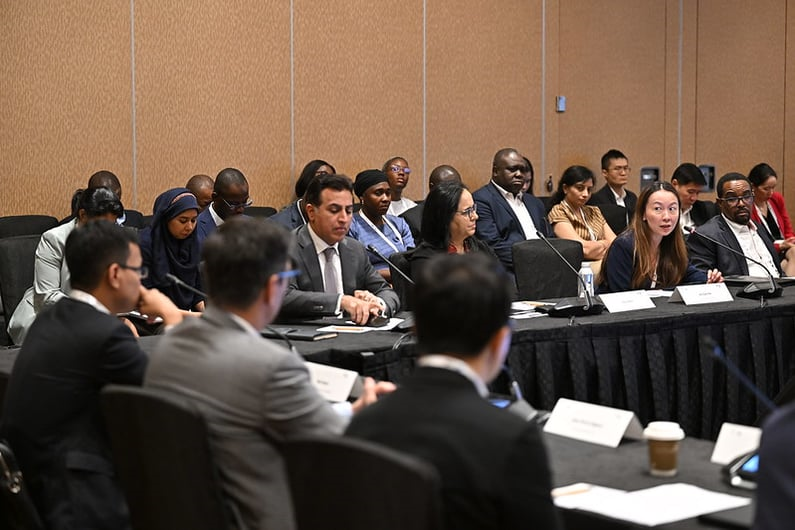By Anu Madgavkar, Marco Piccitto, Olivia White, María Jesús Ramírez, Jan Mischke, and Kanmani Chockalingam
MSMEs are vital for growth and jobs, but struggle with productivity. The route to higher productivity lies in creating a win-win economic fabric for all companies.
At a glance
- Micro-, small, and medium-size enterprises (MSMEs) form the backbone of economies. Across the 16 countries we examine, MSMEs account for two-thirds of business employment in advanced economies—and almost four-fifths in emerging economies—as well as half of all value added. They also power dynamism and will play an important role in preserving competitiveness in an era of shifting global production.
- Boosting MSME productivity relative to large companies could yield significant value. Small business productivity is only half that of large companies, and less in emerging economies. Raising MSMEs to top-quartile levels relative to large companies is equivalent to 5 percent of GDP in advanced economies and 10 percent in emerging economies.
- Capturing this value requires a fine-grained view. Relative productivity of MSMEs and large companies varies widely across subsector and country. For example, in virtually all countries, eight subsectors out of 24 drive more than 60 percent of the value of narrowing the productivity gap in manufacturing, but the top ones vary by country.
- A win-win economic fabric can improve productivity for both MSMEs and large enterprises. MSME and large company productivity move in tandem in most subsectors, indicating spillovers if the right conditions are created. For example, automotive MSMEs have gained operational proficiency through systematic interactions with productive original equipment manufacturers, and small software developers have benefited from talent and capital ecosystems seeded by larger companies.
- All stakeholders have a role to play in developing granular productivity strategies. In subsectors where both small and large companies lag, infrastructure and policy improvements can target both together. Where MSMEs struggle but large enterprises outperform, building networks among them helps. Even where both large and small companies do well, strengthening their interactions could boost productivity.
Micro-, small, and medium-size enterprises (MSMEs) are the lifeblood of economies around the world. They account for more than 90 percent of all businesses, roughly half of value added, and more than two-thirds of business employment.1
But small businesses lag behind large companies on productivity. On average, their labor productivity, or value added per worker, is half that of their larger peers. Accelerating productivity growth has always been the sure way to deliver long-term prosperity, and MSMEs can—must—play a crucial role. Their contribution is potentially even more important amid the beginnings of a reconfiguration of global trade patterns.2 Such shifts are unlikely to translate into a meaningful long-term realignment without a competitive network of MSMEs supporting and complementing large companies.
If MSMEs were to narrow the productivity gap with large companies, not only could that breathe new life into economy-wide productivity, employment, and growth, but economies and companies could raise their resilience in an uncertain world. The question is how.
Only by studying MSMEs at the fine-grained level can we understand where and why opportunities exist and plot a path toward higher productivity for all. After all, MSMEs are immensely varied. They range from a self-employed individual, such as a taxi driver or an online game designer; to a microenterprise with one to nine employees, like a laundry or a dental practice; to a small enterprise with up to 50 employees, such as a bakery or local auto repair chain; to a medium-size furniture manufacturing company or software business employing up to 250 people.
In this research, the McKinsey Global Institute (MGI) has aggregated a richly granular data set of MSME productivity across sectors and subsectors for 16 countries with different income levels accounting for more than 50 percent of global GDP. In this group (listed by per capita GDP in 2021 in purchasing power parity terms) are ten advanced economies: the United States, Germany, Australia, the United Kingdom, Italy, Israel, Japan, Spain, Poland, and Portugal; and six emerging economies: Mexico, Brazil, Indonesia, India, Nigeria, and Kenya.3 At the sector level, in the manufacturing sector, for instance, our data cover 24 level-two subsectors and 95 level-three subsectors.4 This enables us to explore the details of businesses that are highly diverse in size, economic context, degree of formalization, and, especially, the nature of economic activity in which they engage (see sidebar “Definitions, scope, and data limitations”). Most previous external analysis has tended to study MSMEs in a single country or has compared productivity among countries within a particular sector.5
This research focuses on the variation in MSME productivity relative to large companies across sectors, subsectors, and countries, enabled by our rich data set. We use this microscopic, but cross-country, lens to spot potential value and identify how MSMEs can work with other companies in specific business contexts to capture it.
Endnotes:
[1] "Micro-, Small and Medium-sized Enterprises Day, 27 June," United Nations, June 2023.
[2] Geopolitical and the geometry of global trade, McKinsey Global Institute, January 2024.
[3] Countries classified as “advanced emerging,” “secondary emerging,” or “frontier” by FTSE Russell have been categorized as emerging economies for this research. For more detail, see FTSE equity country classification September 2023 annual announcement, FTSE Russell, September 2023.
[4] Levels of subsectors are defined by the International Standard Industrial Classification of All Economic Activities (ISIC), Revision 4 or equivalent. See International Standard Industrial Classification of All Economic Activities (ISIC), Rev. 4, United Nations, 2008.
[5] Beldina Owalla et al., “Mapping SME productivity research: A systematic review of empirical evidence and future research agenda,” Small Business Economics, volume 58, issue 3, March 2022.









